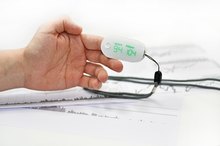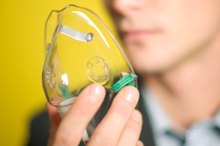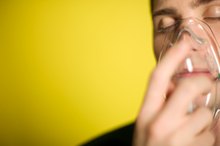How to Use a Finger Pulse Oximeter
A pulse oximeter is a medical device that measures heart rate and the oxygen level in the blood, expressed as the percent of oxygen saturation 1. Pulse oximeters operate by shining light through the skin to the blood vessels below 3. These devices are routinely used in many health care settings and are available over the counter. A high oxygen saturation -- close to 100 percent -- indicates that the red blood cells are fully loaded with oxygen from the lungs.
Turn on the pulse oximeter by firmly pressing the power button 3. The screen should light up almost instantly.
How to Pair a Sensor Receiver Heart Monitor With the Garmin 305
Learn More
Place the sensor -- the part that opens and closes like a clothespin -- on any finger, with the sensor screen above the fingernail. If the sensor doesn't have a screen, run the cable along the back of the finger or hand. Don't use the thumb because readings are less reliable than finger readings.
Wait quietly while the pulse oximeter acquires a signal 1. This may take 10 seconds or more, depending on the device and the conditions. Excessive movement during measurement can decrease the accuracy of the result or may cause an error message.
Disadvantages of Pulse Oximetry
Learn More
Look at the display to see the heart rate, usually indicated with a heart or pulsing light. The percent of oxygen saturation is typically indicated by the symbol "SpO2." Many devices also have a pulse tone that beeps in time with the heart rate.
Leave the sensor on for continuous monitoring. The sensor can become uncomfortable or cause pressure sores if left on the finger too long. Check and/or move the sensor at least every two to four hours. If only a single measurement is required, remove the sensor and press the power button to turn off the device.
Tips
To ensure proper function, read the manual for your specific pulse oximeter.
Remove nail polish, especially dark colors, before placing the sensor on the finger.
Place the sensor on the finger before turning on the pulse oximeter for a faster result.
Pulse oximeters are less accurate if there is poor blood flow to the finger. This may occur if the person is cold, has very low blood pressure or is having a heart attack.
Carbon monoxide -- due to smoke inhalation, carbon monoxide poisoning or heavy cigarette smoking -- results in falsely high pulse oximeter readings.
Altitude may result in lower percent oxygen saturation due to the lower oxygen pressure in the air, particularly if you have recently arrived.
Warnings
A normal percent oxygen saturation reading is in the 95 to 100 percent range. In the event of a low oxygen saturation measurement, look for signs of respiratory distress. This includes shortness of breath, wheezing, difficulty breathing or a bluish discoloration of the face, lips or fingernails.
Seek medical attention right away if the respiratory distress is a new or uncomfortable symptom. if it's getting worse or if the pulse oximeter measurement is below 90 percent.
Related Articles
References
- NursingTimes.net: The Correct Use of Pulse Oximetry in Measuring Oxygen Status
- International COPD Coalition: Clinical Use of Pulse Oximetry
- The Journal for Nurse Practinioners: Pulse Oximetry: Uses and Limitations
- Pandya NK, Sharma S. Capnography And Pulse Oximetry. [Updated 2020 Jan 30]. In: StatPearls [Internet]. Treasure Island (FL): StatPearls Publishing; 2020 Jan-. Available from: https://www.ncbi.nlm.nih.gov/books/NBK539754/
- Castro D, Keenaghan M. Arterial Blood Gas. [Updated 2020 Feb 20]. In: StatPearls [Internet]. Treasure Island (FL): StatPearls Publishing; 2020 Jan-. Available from: https://www.ncbi.nlm.nih.gov/books/NBK536919/
- Torp KD, Simon LV. Pulse Oximetry. [Updated 2019 Apr 28]. In: StatPearls [Internet]. Treasure Island (FL): StatPearls Publishing; 2020 Jan-. Available from: https://www.ncbi.nlm.nih.gov/books/NBK470348/
- Plüddemann A, Thompson M, Heneghan C, Price C. Pulse oximetry in primary care: primary care diagnostic technology update. Br J Gen Pract. 2011;61(586):358–359. doi:10.3399/bjgp11X572553
- Shah SA, Velardo C, Farmer A, Tarassenko L. Exacerbations in Chronic Obstructive Pulmonary Disease: Identification and Prediction Using a Digital Health System. J Med Internet Res 2017;19(3):e69.
- Vold ML, Aasebø U, Wilsgaard T, Melbye H. Low oxygen saturation and mortality in an adult cohort: the Tromsø study. BMC Pulm Med. 2015;15:9. Published 2015 Feb 12. doi:10.1186/s12890-015-0003-5
- Pandya NK, Sharma S. Capnography And Pulse Oximetry. [Updated 2020 Jan 30]. In: StatPearls [Internet]. Treasure Island (FL): StatPearls Publishing; 2020 Jan-.
- Castro D, Keenaghan M. Arterial Blood Gas. [Updated 2020 Feb 20]. In: StatPearls [Internet]. Treasure Island (FL): StatPearls Publishing; 2020 Jan-.
- Torp KD, Simon LV. Pulse Oximetry. [Updated 2019 Apr 28]. In: StatPearls [Internet]. Treasure Island (FL): StatPearls Publishing; 2020 Jan-.
- Johns Hopkins University Medicine. Pulse Oximetry. 2019.
- Shah SA, Velardo C, Farmer A, Tarassenko L. Exacerbations in Chronic Obstructive Pulmonary Disease: Identification and Prediction Using a Digital Health System. J Med Internet Res. 2017;19(3):e69. Published 2017 Mar 7. doi:10.2196/jmir.7207
- Shah SA, Velardo C, Farmer A, Tarassenko L. Exacerbations in Chronic Obstructive Pulmonary Disease: Identification and Prediction Using a Digital Health System. Eysenbach G, ed. Journal of Medical Internet Research. 2017;19(3):e69. doi:10.2196/jmir.7207
- Fahy B, Lareau S, Sockrider M. Pulse Oximetry. American Journal of Respiratory and Critical Care Medicine. American Thoracic Society. 2011;184: 1.
Resources
Writer Bio
Shannon Campbell is a scientist and a small business owner. Based in Boulder, Colo., she is passionate about health and medical technologies. She holds a bachelor’s degree in human biology and biochemistry from the University of Guelph, and a PhD in human physiology from the University of Melbourne.








